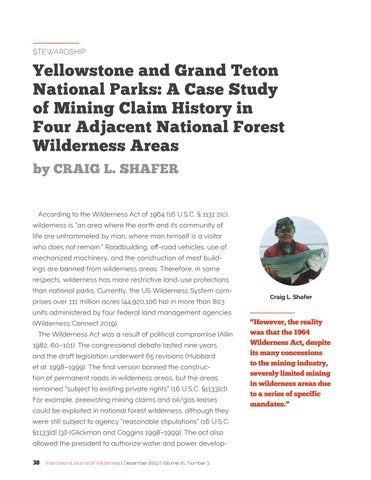STEWARDSHIP
Yellowstone and Grand Teton National Parks: A Case Study of Mining Claim History in Four Adjacent National Forest Wilderness Areas by CRAIG L. SHAFER
According to the Wilderness Act of 1964 (16 U.S.C. § 1131 2(c), wilderness is “an area where the earth and its community of life are untrammeled by man, where man himself is a visitor who does not remain.” Roadbuilding, off-road vehicles, use of mechanized machinery, and the construction of most buildings are banned from wilderness areas. Therefore, in some respects, wilderness has more restrictive land-use protections than national parks. Currently, the US Wilderness System comprises over 111 million acres (44,920,106 ha) in more than 803
Craig L. Shafer
units administered by four federal land management agencies (Wilderness Connect 2019). The Wilderness Act was a result of political compromise (Allin 1982, 60–101). The congressional debate lasted nine years and the draft legislation underwent 65 revisions (Hubbard et al. 1998–1999). The final version banned the construction of permanent roads in wilderness areas, but the areas remained “subject to existing private rights” (16 U.S.C. §1133[c]). For example, preexisting mining claims and oil/gas leases could be exploited in national forest wilderness, although they were still subject to agency “reasonable stipulations” (16 U.S.C. §1133[d] [3]) (Glickman and Coggins 1998–1999). The act also allowed the president to authorize water and power develop38
International Journal of Wilderness | December 2019 | Volume 25, Number 3
“However, the reality was that the 1964 Wilderness Act, despite its many concessions to the mining industry, severely limited mining in wilderness areas due to a series of specific mandates.”
